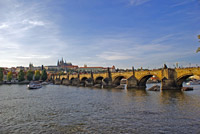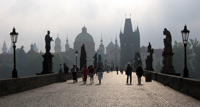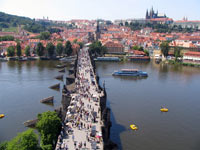Charles Bridge (Karlův most)
The nearest hotels
- Hotel U Páva (218 m)
- King George´s House (392 m)
- Hotel Best Western Roya … (441 m)
- Botel Florentina (471 m)
- Hotel Old Prague (616 m)
The nearest sightseeings
- Old Town Bridge Tower (146 m)
- Kampa (215 m)
- Lesser Town Bridge Tower (347 m)
- Clementinum (397 m)
- Rudolfinum (446 m)
The Charles Bridge (Czech: Karlův most) is a famous historic bridge that crosses the Vltava river in Prague, Czech Republic. Its construction started in 1357 under the auspices of King Charles IV, and finished in the beginning of the 15th century. As the only means of crossing the river Vltava (Moldau) until 1841, the Charles Bridge was the most important connection between Prague Castle and the city's Old Town and adjacent areas. This "solid-land" connection made Prague important as a trade route between Eastern and Western Europe. The bridge was originally called the Stone Bridge (Kamenný most) or the Prague Bridge (Pražský most) but has been the "Charles Bridge" since 1870.
The bridge is 516 meters long and nearly 10 meters wide, resting on 16 arches shielded by ice guards. It is protected by three bridge towers, two of them on the Lesser Quarter side and the third one on the Old Town side. The Old Town bridge tower is often considered to be one of the most astonishing civil gothic-style buildings in the world. The bridge is decorated by a continuous alley of 30 statues and statuaries, most of them baroque-style, originally erected around 1700 but now all replaced by replicas.
During the night the Charles Bridge is a quiet place. But during the day it changes its face into a very busy place, with painters, owners of kiosks and other traders alongside numerous tourists crossing the bridge.
History
Through the 19th century
Throughout its history, the Charles Bridge suffered several disasters and witnessed many historic events. A flood in 1432 damaged three pillars. In 1496 the third arch (counting from the Old Town side) broke down after one of the pillars lowered, being undermined by the water (repairs were finished in 1503). A year after the Battle of White Mountain, when the 27 leaders of the anti-Habsburg revolt were executed on 21 June 1621, the Old Town bridge tower served as a deterrent display of the severed heads of the victims to stop Czechs from further resistance. During the end of the Thirty Years' War in 1648, the Swedes occupied the west bank of the Vltava, and as they tried to advance into the Old Town the heaviest fighting took place right on the bridge. During the fighting, they severely damaged one side of the Old Town bridge tower (the side facing the river) and the remnants of almost all gothic decorations had to be removed from it afterward. During the late 17th century and early 18th century the bridge gained its typical appearance when an alley of baroque statues was installed on the pillars. During a great flood in 1784, five pillars were severely damaged and although the arches did not break down, the traffic on the bridge had to be greatly restricted for some time.
The original stairway to Kampa Island was replaced by a new one in 1844. The next year, another great flood threatened the bridge, but the bridge escaped major damage. In 1848, during the revolutionary days, the bridge escaped unharmed from the cannonade, but some of the statues were damaged. In 1866, pseudo-gothic gas (later changed to electric) lights were erected on the balustrade. In the 1870s, the first regular public-transport (omnibus) line went over the bridge (officially called "Charles Bridge" after 1870), later replaced by a horse tram. The bridge towers underwent a thorough reconstruction between 1874 and 1883.
On 2–5 September 1890, another disastrous flood struck Prague and severely damaged the Charles Bridge. Thousands of rafts, logs and other floating materials that escaped from places upstream gradually formed a huge barrier leaning against the bridge. Three arches were torn down from the great pressure and two pillars collapsed from being undermined by the water, while others were partly damaged. With the fifth pillar, two statues - St. Ignatius of Loyola and St. Xavier, both by Ferdinand Brokoff - also fell into the river. The former statue was replaced by a statuary of Saints Cyril and Methodius by Karel Dvořák; the latter was replaced by a replica of the original. Repair works lasted for two years (the bridge was reopened on 19 November 1892) and cost 665,000 crowns.
20th century to present
In the beginning of the 20th century, the Charles Bridge saw a steep rise of heavy traffic. The last day of the horse line on the bridge was 15 May 1905, when it was replaced with an electric tram and later, in 1908, with buses. At the end of World War II, a barricade was built in the Old Town bridge tower gateway. A capital repair of the bridge took place between 1965 and 1978, based on a collaboration among various scientific and cultural institutes. The stability of the pillars was reassured, all broken stone blocks were replaced, and the asphalt top was removed. All vehicular traffic has been excluded from the Charles Bridge since then, making it accessible by pedestrians only. The repair cost 50 million crowns.
During the 1990s, some people started criticizing the previous reconstruction of the bridge and proposing a new one. As of the beginning of the new millennium, most of the experts appeared to agree that the previous reconstruction had not been flawless but disputed the need for further interference with the bridge. However, after the disastrous floods of 2002 (which themselves caused only minor harm to the bridge), it was decided that repair and stabilization of the two pillars (numbers 8 and 9) on the Malá Strana side of the bridge would happen. These are the only river pillars that were not repaired after the 1890 floods. The floods intensified the voices of those supporting an overall bridge reconstruction. Work started in late 2008 and is scheduled to continue through 2010. The repair includes bolstering the pillars and building a new hydroisolation system protecting the bridge. It also encompasses the replacement of many of the stones in the bridge walls, a matter which has become enormously controversial due to the heavy handed and, many say, inappropriate approach adopted by the restoration team. The result has been highly criticised by conservation professionals all over Europe (see photos on external links). Even laypeople walking across the bridge can easily see that dozens of new replacement "stones" do not match the historical ones they are next to. The whole reconstruction is being done gradually, closing off parts of the bridge without needing to close the span in its entirety.
Statues on the bridge
The avenue of 30 mostly baroque statues and statuaries situated on the balustrade forms a unique connection of artistic styles with the underlying gothic bridge. Most sculptures were erected between 1683 and 1714. They depict various saints and patron saints venerated at that time. The most prominent Bohemian sculptors of the time took part in decorating the bridge, such as Matthias Braun, Jan Brokoff, and his sons Michael Joseph and Ferdinand Maxmilian.
Among the most notable sculptures, one can find the statuaries of St. Luthgard, the Holy Crucifix and Calvary, and St. John of Nepomuk. Well known also is the statue of the knight Bruncvík, although it was erected some 200 years later and does not belong to the main avenue.
Beginning in 1965, all of the statues have been systematically replaced by replicas, and the originals have been exhibited in the lapidarium of the National Museum.
Source: wikipedia.org, licence CC-BY-SA-3.0
Photos
Map
Operator
- Phone: +420 261 264 369
- E-mail: info@arcadira.eu
Tourist information
Tourist Information about Prague and Czech republic. History, Culture, Language, Currency, Visa and much more.
List of our Prague hotels
Prague hotels - 3 star
- Botel Albatros
- Botel Florentina
- Botel Racek
- Hotel Ankora
- Hotel Arbes - Mepro
- Hotel Atos
- Hotel Donatello
- Hotel Globus
- Hotel Gloria
- Hotel ILF
- Hotel Legie
- Hotel Old Prague
- Hotel Olsanka
- Hotel Olympik Tristar
- Hotel Victoria
- King George´s House
Prague hotels - 4 star
- Hotel Adria
- Hotel Amigo
- Hotel Arkada
- Hotel Barceló
- Hotel Barceló Old Town
- Hotel Caesar Palace
- Hotel Corinthia Panorama
- Hotel Golf
- Hotel Holiday Inn Congress Centre
- Hotel Louis Leger
- Hotel Majestic Plaza
- Hotel Olympik
- Hotel Pyramida
- Hotel Roma
- Hotel Step
- Hotel U Krále Karla
- Hotel U Páva
- Hotel Yasmin
Prague hotels - 5 star
Contact
- Pragap Tour, s.r.o. (Arcadira)
- Liliová 10
- 110 00, Praha 1
- Česká republika
- Phone: +420 261 264 369
- Fax: +420 244 400 157
- E-mail: info@arcadira.eu
- Facebook: www.facebook.com
- ICO: 25147412
- DIC: CZ25147412
© 2008-2024 Pragap Tour, s r.o. (Arcadira) | All Rights Reserved | Terms & Conditions | Created by Jaroslav Salivar


